Updated: New Visions Curriculum Promotes a Distorted View of Israel
UPDATE:
New Visions has removed the lessons discussed below and is in the process of rewriting them.
Introduction
In 2024, New Visions for Public Schools, a popular high school curriculum, added a module to its Global History unit called “Decolonization and Nationalism.” This unit includes a five-lesson module entitled “Nationalism in West Asia” that contains a distorted and simplistic account of the Arab-Israeli conflict that depicts Jewish settlers strictly as oppressors of indigenous Palestinians. It fails to explain the enduring connection of the Jewish people to the land since antiquity. The module conceals the relentless vilification of Jews that has permeated Arab discourse since the conflict began and ignores the role of Palestinian terrorism and the stubborn refusal of Palestinians and their supporters to peacefully coexist with the Jewish state. By adopting this flawed unit, New Visions is taking sides and strayed from its mission of providing students with an accurate and complete history.
The module presents historic events without necessary contextual information. For example, the text presents Arab mob violence against Jews during the Mandate period (1920-1947) simply as clashes without clarifying that the Arabs initiated the violence. In contrast, forceful Jewish actions are presented without situational context to understand what prompted them. For example, when discussing the 1982 Lebanon War, the curriculum neglects to mention that Israel invaded Lebanon because the Palestine Liberation Organization had turned the country into a terrorist base and was launching cross border attacks on Israel, frequently targeting civilians.
There are also clearcut errors. For example, the module states that Arabs were not present at the Paris Peace Conference after World War I, when, in fact, an Arab delegation led by Emir Faisal, the son of the Sherif of Mecca, represented Arab interests there. Such errors require correction.
Detailed Analysis of the Lessons
Lesson 1: Competing Interests in West Asia: Nationalism, Imperialism, and Zionism (1800s-1914/pre-WWI)
This first lesson describes the three important movements in the Middle East during the late 19th and early 20th century: European Imperialism, Arab Nationalism, and Zionism. Students are instructed to consider the goals of each of these movements and their comparative strengths. The section copied below asserts that the Arabs in Palestine were “native” but ignores the much longer historic presence of Jews on the land.

The module repeatedly states that the Arabs living in Palestine had been there for generations and centuries. It refers to them as natives in lesson 3.
In fact, many of the Arabs in Palestine were recent immigrants, and their descendants were drawn to the economic development the Zionists had brought to territory. The British authorities acknowledged in a report from 1937 that Arabs had been drawn to areas Jews had developed:
The general beneficent effect of Jewish immigration on Arab welfare is illustrated by the fact that the increase in the Arab population is most marked in urban areas affected by Jewish development. A comparison of the census returns in 1922 and 1931 shows that, six years ago, the increase percent in Haifa was 86, in Jaffa 62, in Jerusalem 37, while in purely Arab towns such as Nablus and Hebron it was only 7, and at Gaza there was a decrease of 2 percent.
Franklin Roosevelt stated in 1939 that, “Arab immigration into Palestine since 1921 has vastly exceeded the total Jewish immigration during this whole period.”
Meanwhile, Jews had lived in the land since antiquity. Although the size of the Jewish community had precipitously declined over the centuries due to persecution, there always was some Jewish presence. Furthermore, Jews around the world maintained historical memory and a connection to the Land of Israel, and there was immigration to the historic Jewish homeland in every generation even before the Zionist movement.
Lesson 2: Mandates in West Asia
This lesson teaches about the establishment of the mandate system after World War II and its impact on Jews and Arabs in Palestine. The lesson suffers from misleading framing and outright falsehoods, for example, that the Arabs were not invited to the Paris Peace Conference. Britain made contradictory assurances to both Arabs and Jews only to not fulfill any of them to cut a deal with France. However, the lesson only focuses on the betrayal of the Arabs by the British while downplaying the downside of the mandates for the Jews.
- Questions on McMahon letter vs. Balfour Declaration
![]()
![]()
Students are asked to analyze both the McMahon letter and the Balfour declaration for the conflicting promises made by the British to Jews and Arabs. While this is an important part of the history of the conflict, the documents are presented in an unbalanced manner.
For the McMahon letter, the students are asked to simply summarize the document, while for the Balfour declaration, students are questioned about the reaction of non-Jews in Palestine to the Declaration. By subjecting only the Balfour Declaration to consideration of the point of view of its opponents, New Visions establishes a pattern of imbalanced treatment; Zionist voices are largely missing, and those Jewish voices that are included appear either as critics of Israel or are treated critically in the text.
- Arthur Balfour is misrepresented as an antisemite by distorting a quotation.

-
- The lesson misleadingly claims that Arthur Balfour was an antisemite. This shifts the focus from his support for a movement of Jewish self-determination to a means for antisemitic, imperialist xenophobes or bigots to rid their country of the Jews.
The proof offered for Balfour’s supposed antisemitism comes from the introduction he wrote to Nahum Sokolow’s History of Zionism. The quote in question reads as follows: “[Zionism would] mitigate the age-long miseries created for Western civilization by the presence in its midst of a Body [the Jews] which it too long regarded as alien and even hostile.” New Visions characterizes this quote as Balfour calling Jews alien and hostile. However, a full reading of the section makes clear that Balfour is not criticizing Jews, but is criticizing Europe for regarding Jews as alien and hostile. His thesis is that Europe has sinned in its treatment of the Jews. Balfour argues that Europeans should support Zionism because it will help them overcome their own antisemitism. Rather than being an antisemitic screed, Balfour’s introduction is a philosemitic call to action.
- Falsified historical account: Arabs not invited to Paris Peace Conference

-
- New Visions asserts that Arab representatives were not invited to the Paris Peace Conference that followed World War I, and, thus, the promises made to them were overlooked. This is false history. In fact, Emir Faisal, the son of Sherif Hussein of Mecca, led the Arab delegation to Versailles with T.E. Lawrence, where he advocated the establishment of an independent Arab state. There he also met with Chaim Weizmann and the two signed the Faisal-Weizmann agreement, where they agreed to cooperate in establishing independent Jewish and Arab States in the Middle East. In addition, this paragraph suggests that the Arabs were betrayed at the Peace Conference while Zionists were allowed to settle in Palestine. This framing misses the fact that Zionists’ aspirations were also ignored, as the Palestine Mandate was soon cut in half to create the Kingdom of Transjordan under Faisal’s brother Abdullah.
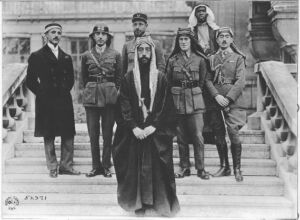
The Arab delegation to the Paris Peace Conference with Emir Feisal front and center
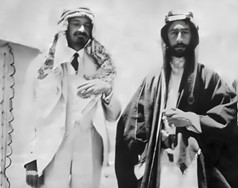
Emir Feisal and Chaim Weizmann at the signing of the Feisal-Weizmann Agreement
Lesson 3: Partition of Palestine and Israel Independence
This lesson describes the UN partition plan and the founding of the State of Israel. The lesson begins with an activity where students analyze a Jewish, Arab, and Bedouin perspective of Zionism. However, the lesson only presents the Arab view of Israel’s founding. The lesson even presents the Arab riots in 1921, 1929, and 1936 as clashes between Jews and Arabs rather than accurately describing these as Arab attacks on Jewish communities.
- Jews stealing land and jobs in the Arab and Bedouin narratives
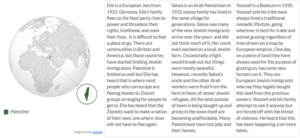
-
- This lesson has students view the period before 1948 from the viewpoints of three children: one Jew, one Palestinian Arab, and one Bedouin. The Jewish account is of a boy in Germany who seeks to escape the Nazi regime in Palestine. In the Arab account, a boy living in a village witnesses the growing tensions between Jews and Arabs. In the Bedouin account, European Jewish immigrants prevent the Bedouins from using their traditional grazing land.
However, the idea that Jewish settlement in Palestine displaced the Arab residents is untrue, in fact, Arabs were drawn to Palestine by the economic development brought by the Zionists. In the Bedouin narrative, the vague “previous owner” is not the Arabs as one might infer, but is rather, the foreign governing power: first the Ottomans and then the British.
- Riots are presented as clashes, not Arab-instigated violence against Jews.

-
- The lesson characterizes the bouts of violence in 1920, 1929, and 1936 as clashes between Muslims and Jews. However, this lacks the crucial context that the Muslims attacked Jewish communities first, including communities that were not even Zionist, such as in Hebron. Arab leaders such as the Grand Mufti Haj Amin al-Husseini incited Arabs to these attacks with disinformation that Jews were planning to take over the Al-Aqsa Mosque and the Cave of the Patriarchs. Jewish paramilitary groups were only founded in response to the attacks as Jews sought to defend themselves.
- Supposed harmony in Arab lands between Jews and Muslims

-
- New Visions states that Jews, Christians and Muslims lived in relative harmony in the Arab world prior to 1948. This glosses over the perpetual insecurity of the Jewish population in Muslim-ruled lands, leaving out the important fact that Jews and Christians did not enjoy the same rights as Muslims and had to pay extra taxes along with other restrictions on their lives. The quote from the Iraqi Foreign Minister tacitly admits that antisemitism is rampant in the Arab world if Arabs will be incited against their Jewish neighbors because of the actions of Jews in other countries.
Lesson 4: Nakba, Intifada, and Israeli Wars
This lesson focuses on the aftermath of 1948 war and the Israeli-Arab conflict until today. Much like the previous lesson, this one continues to mostly present the Arab perspective. The only time the lesson gives us a Jewish perspective is an excerpt from Yitzhak Rabin’s memoir where he discusses expelling Arabs from the city of Lydda. But the lesson doesn’t explain why the Haganah chose to expel the Arab population of this city, nor does it tell students about the expulsions of Jews from The Old City, East Jerusalem, and the Gush Etzion bloc. Its account of later conflicts, like the Lebanon War in 1982, is similarly incomplete. The following example illustrates this:
- The account of the 1948 War is presented entirely from the Palestinian perspective. From the lesson, one would never know that Palestinian militias initiated the violence or that Jews were expelled from their homes in the Old City of Jerusalem and Judea and Samaria. It includes testimony from Palestinian refugees, but none from Jews who were expelled.


The only Jewish or Israeli source on the 1948 war is the aforementioned Yitzhak Rabin excerpt about expulsions. The way this excerpt is framed is misleading, as the title focuses on the fact that the section was censored by the government. In doing so, New Visions creates the false and prejudicial impression that Israel must hide its past to justify its legitimacy.
- Only Israel is described as expanding into Palestinian territory, not Egypt and Jordan.

-
- While New Visions describes Israeli territorial gains in 1948 as “expand[ing] into Palestinian territory,” Egypt and Jordan are said to occupy the Gaza Strip, West Bank, and East Jerusalem. The issue here is that those territories were also meant to be part of the proposed Arab State, and East Jerusalem was meant to be part of an international zone. The writers demonstrate inconsistency. Either all of the actors expanded into “Palestinian” territory or none of them did. But only Israel is described as doing so. The intent here seems to be to blame Israel for the lack of Palestinian state in 1948 while ignoring the actions of other Arab powers, including the Palestinian Arabs themselves who initiated the war and lost.
- Arab war aims in 1973 were just to recapture “occupied territory.”
-
- While it is true that Egypt only sought to retake the Sinai, as evidenced by the plan to stay under the antiaircraft umbrella. The Syrians were determined to destroy the State of Israel as the ruling Ba’ath party had laid out at its 1966 party conference.
- No explanation is offered as to why Israel wanted to suppress Palestinian militias in 1982.

-
- The lesson does not mention that the PLO was using Lebanon as a base from which to launch rockets and perpetrate terrorist attacks inside Israel, such as the 1978 Coastal Road massacre or the massacre of Jewish students at a kibbutz.
- The Guardian article blames the failure of the Oslo accords on Netanyahu.

-
- Shlaim is a noted critic of Israel. In fact, the individuals directly involved in the negotiations, including President Bill Clinton, have emphatically stated that Arafat was at fault and could have had almost everything he wanted had he accepted the peace deal. President Clinton said, “So a couple of days before I leave office, Arafat says, calls to tell me what a great man I am. And I just said, ‘No, I’m not. On this I’m a failure, and you made me a failure'” (PBS NewsHour, July 7, 2004).
Lesson 5: Why is there conflict in Israel-Palestine?
This lesson uses a video from CBS News to give students an overview of the Israeli-Palestinian conflict. Just like the rest of the curriculum, this video is biased against Israel. It downplays Arab and Palestinian aggression and portrays the intractability of the conflict as Israel’s fault, despite Israeli peace offers in 1948, 1967, 1994, 2000 and 2008. All of these were rejected by the Arabs.
- Only Jewish militias are referred to in the video.

-
- The lesson neglects to mention that there were Palestinian groups as well, and the Jewish militias were founded largely in response to the violence perpetrated by these groups. In addition, the Jewish militias acted purely to protect Jewish communities until the late 1940s when they turned against the British Mandate.
- Arab rejection of partition is presented as being about opposition to imperialism, not antisemitism.

-
- While it is true that Arabs were wary of imperialism, an important factor in their opposition to the partition plan was that they refused to grant Jews sovereignty in any “Muslim land.” Earlier in the module, the Iraqi UN ambassador is quoted as follows: “Any injustice imposed upon the Arabs in Palestine will disturb the harmony among Jews and non-Jews in Iraq.” The fact that Jewish sovereignty would upset interreligious “harmony” in Iraq suggests that imperialism was not the only motivation behind Arab opposition to a Jewish State.
- The video claims Arab states went to war for the Palestinians, not for their own interests.
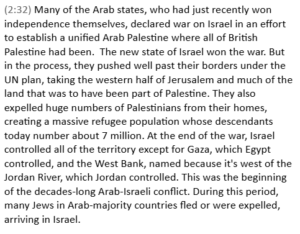
-
- This begs the question of why they did not then allow the Palestinians to found a state in Gaza and Judea and Samaria following the war.
- The video doesn’t say that the Gaza blockade was due to terrorist attacks from Gaza, effectively reversing cause and effect for the on-going violence.
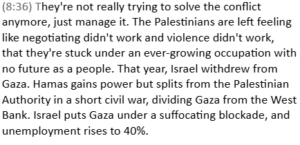
-
- When Israel first disengaged from Gaza, there was no blockade, and when terrorists launched rockets, Israel still did not impose a blockade. Even after Hamas abducted Israeli soldier Gilad Shalit, Israel did not impose a blockade. The blockade did not begin until Hamas violently seized total control of the Gaza strip from the Palestinian Authority in 2007.
Conclusion
In the rest of its history curriculum, New Visions presents the subject in an engaging and objective manner. Unfortunately, their Israel module does not live up to the organization’s standards. Instead of an unbiased recounting of Israeli history, “Nationalism in West Asia” adopts an anti-Israel account that omits essential context and distorts established historical facts. Especially in light of the rise in anti-Jewish incidents in many schools, teaching the history of the Arab-Israeli conflict requires close attention to factual accuracy and objectivity. Sadly, New Visions fails in this task; it is highly misleading and historically false to present Israelis as settler-colonialist oppressors of indigenous people. They are not. Students require a more accurate recounting of history.

 Education Institute
Education Institute


